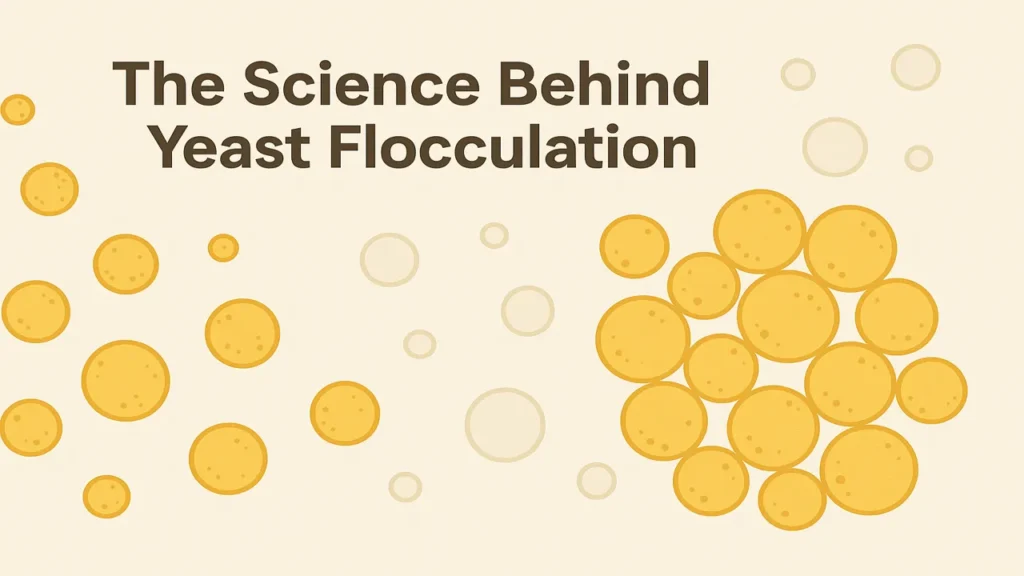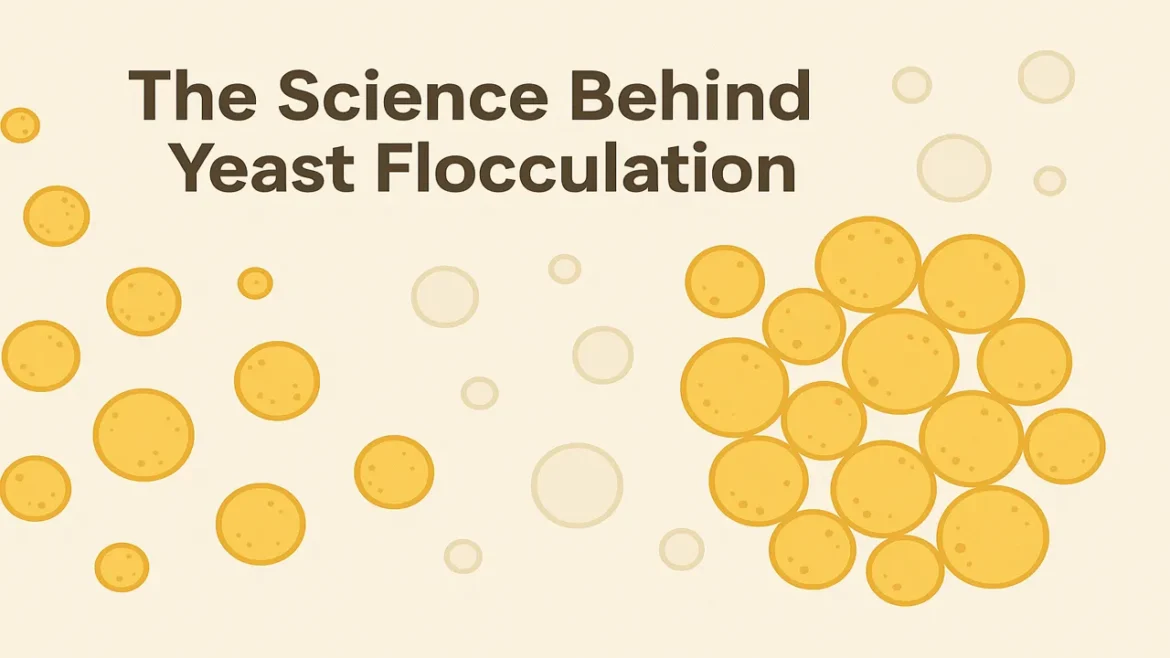Uncover the fascinating science behind yeast flocculation and how it dramatically impacts your homebrew’s clarity, flavor profile, and quality. Learn expert techniques to control this crucial brewing process, from selecting the right yeast strains to optimizing fermentation conditions. Discover why some beers clear beautifully while others remain cloudy with insights from microbiologist Tyler Yeastman.

Have you ever wondered why some beers clear beautifully while others remain stubbornly cloudy? The secret lies in a process called yeast flocculation – a fascinating biological phenomenon that significantly impacts your homebrew’s clarity, flavor profile, and overall quality. As homebrewers, understanding this process can help us make informed decisions about yeast selection and brewing techniques to achieve our desired results.
What Is Yeast Flocculation?
Flocculation is the process where yeast cells clump together and settle out of suspension after they’ve completed fermentation. Think of it as yeast’s way of saying, “My work here is done!” This natural phenomenon occurs when yeast cells, having consumed available sugars and produced alcohol, begin to stick to each other, forming larger aggregates that are heavy enough to sink to the bottom of your fermenter.
The term comes from the Latin word “floccus,” meaning “a tuft of wool,” which accurately describes the fluffy clumps that yeast forms when flocculating. This process is crucial not only for clarity but also plays a significant role in flavor development and stability of your final brew.
The Biochemistry of Yeast Flocculation
At the molecular level, yeast flocculation is a complex dance of proteins, calcium ions, and cell wall components. The primary players in this process are special proteins called lectins (specifically mannose-binding lectins) found on the cell walls of yeast. These lectins act like tiny hands that can grab onto mannose sugars present on neighboring yeast cells.
Research conducted at the University of Leuven has shown that these lectin-sugar interactions are calcium-dependent, meaning calcium ions act as necessary bridges to enable the binding. Without sufficient calcium in your wort, the flocculation process can be significantly inhibited.
The specific lectin involved is encoded by a family of genes called FLO genes (FLO1, FLO5, FLO8, FLO9, and FLO10). Different yeast strains have different variations of these genes, which explains why some yeasts flocculate readily while others remain stubbornly in suspension.
Types of Yeast Flocculation Behavior
Brewing yeasts exhibit various flocculation patterns that brewers categorize into several types:
High Flocculation (Flocculent Yeasts)
These yeast strains eagerly clump together and drop out of suspension quickly once fermentation slows down. They typically create clearer beers with minimal filtration needed. English ale yeasts like Wyeast 1968 (London ESB) and White Labs WLP002 (English Ale) are famous for their high flocculation.
High flocculation yeasts are ideal for traditional British styles such as bitters and porters, where clarity is desired without extensive aging or filtration.
Medium Flocculation
The middle-ground performers, these yeasts settle at a moderate rate. They offer a good balance between flavor development and clarity. Many American ale yeasts fall into this category, providing versatility for various beer styles.
Low Flocculation (Non-flocculent Yeasts)
These strains stay suspended in your beer for extended periods. While they can create challenges for clarity, they excel at creating complex flavor profiles as they continue to interact with the beer. German Hefeweizen yeasts like Wyeast 3068 are intentionally low-flocculating to create the characteristic cloudy appearance and enhance flavor development.
Factors Affecting Yeast Flocculation
Understanding what influences flocculation can help you manipulate the process to achieve your brewing goals. Several key factors affect how and when your yeast will flocculate:
1. Genetics
The most significant factor is the genetic makeup of your chosen yeast strain. As mentioned earlier, different strains have different FLO gene expressions, which directly impact their flocculation behavior.
2. Wort Composition
The chemical composition of your wort matters tremendously:
- Calcium Levels: Calcium ions are essential cofactors for lectin binding. Brewing water with at least 50-100 ppm of calcium supports proper flocculation.
- Sugar Concentration: As fermentable sugars are depleted, flocculation is triggered. Some yeasts begin flocculating only when sugar levels drop below a certain threshold.
- Alcohol Content: Higher alcohol levels typically promote flocculation, as alcohol creates stress on yeast cells.
- pH Level: Flocculation occurs more readily in slightly acidic environments (pH 3.5-4.5), which is fortunately the natural pH range of most finished beers.
3. Fermentation Conditions
How you conduct your fermentation significantly affects flocculation:
- Temperature: Generally, cooler temperatures promote flocculation once fermentation is complete. This is why lagers, fermented at cooler temperatures, often clear more readily than ales.
- Pressure: Increased pressure can enhance flocculation in some strains.
- Agitation: Excessive movement or stirring keeps yeast in suspension and can disrupt flocculation. However, some agitation during active fermentation is beneficial for yeast health.
4. Age of the Yeast Culture
Older yeast cells typically flocculate more readily than younger ones. This is partly why repitching yeast from a previous batch sometimes results in faster flocculation.
Practical Applications for Homebrewers
Now that we understand the science, let’s explore how to apply this knowledge to improve our homebrewing practice:
Selecting the Right Yeast for Your Style
Choose your yeast strain based on the desired clarity and flavor profile of your target beer style:
- For clear English ales: Select highly flocculent strains like Wyeast 1968
- For cloudy Hefeweizens: Choose low-flocculating strains like Wyeast 3068
- For balanced American ales: Medium-flocculating strains like Wyeast 1056 work well
Manipulating Flocculation During Brewing
Several techniques can help you control flocculation:
1. Water Chemistry Adjustments
Ensure adequate calcium levels in your brewing water. For most styles, 50-100 ppm calcium is sufficient to support proper flocculation. Calcium chloride or calcium sulfate additions can help achieve this.
2. Temperature Control
Perform a “cold crash” by lowering the temperature of your fermenter to near-freezing (33-40°F/0.5-4.4°C) after fermentation is complete. This encourages yeast to flocculate rapidly.
3. Fining Agents
When additional clarity is needed, fining agents can enhance flocculation:
- Irish Moss or Whirlfloc: Added during the last 15 minutes of the boil, these help precipitate proteins that might otherwise keep yeast in suspension.
- Gelatin: Added post-fermentation, it helps bind with yeast cells and accelerate settling.
- Isinglass: Traditionally used in British brewing, this fish-derived fining agent is highly effective at pulling yeast out of suspension.
4. Timing Your Transfers
Patience is often the best approach. Allow sufficient time for yeast to naturally flocculate before transferring to secondary vessels or packaging. For highly flocculent strains, this might be just a few days after fermentation completes; for less flocculent strains, it could take weeks.
Common Yeast Flocculation Problems and Solutions
Even with perfect planning, flocculation issues can arise. Here are some common problems and how to address them:
Premature Flocculation
Sometimes yeast flocculates before fermentation is complete, resulting in stuck fermentation and potentially under-attenuated beer.
Solution: Gently rouse the yeast by carefully stirring or swirling the fermenter to resuspend the yeast. Consider raising the temperature slightly to increase yeast activity.
Poor Flocculation
When your beer remains cloudy despite sufficient time:
Solution: Cold crash the beer, use appropriate fining agents, or consider filtration as a last resort. For future batches, select a more flocculent yeast strain or adjust your water chemistry.
Yeast Autolysis
When yeast cells remain on the trub too long after flocculation, they can break down (autolyze) and release unpleasant flavors.
Solution: Transfer beer off the yeast cake within 2-4 weeks, depending on temperature and alcohol content. Higher temperatures and alcohol levels accelerate autolysis.
Beyond Clarity: Flavor Impacts of Yeast Flocculation
While clarity is the most visible result of flocculation, its impact extends to flavor development as well:
- Highly flocculent yeast often produces cleaner-tasting beers as the yeast drops out quickly, limiting continued interaction with the beer.
- Low-flocculating yeast typically produces more complex flavor profiles as it remains in contact with the beer longer, continuing to process minor fermentables and releasing various compounds.
- Timing of flocculation affects ester production and the degree of diacetyl reduction, two key components of beer flavor.
Mastering yeast flocculation gives homebrewers powerful control over both the appearance and flavor profile of their beers. While it may seem like a small detail in the brewing process, flocculation behavior can make the difference between a good beer and a great one.
By selecting appropriate yeast strains, optimizing fermentation conditions, and utilizing techniques like cold crashing when needed, you can achieve consistent results that match your vision for each beer style. Remember that flocculation isn’t just about clarity—it’s an integral part of your beer’s complete sensory profile.
Next time you enjoy a pint of your homebrew, take a moment to appreciate the microscopic ballet of yeast cells that made it possible—the clumping together of billions of tiny organisms that transformed sugary wort into the complex beverage in your glass.
About the Author:
Tyler Yeastman is a microbiologist who specializes in wild fermentation. He maintains a library of over 100 isolated wild yeast strains and bacterial cultures collected from around the world. Tyler’s expertise in lambic-style beers, spontaneous fermentation, and mixed-culture brewing has helped countless homebrewers understand the complex interactions between microorganisms and beer. When not in his home lab with custom equipment for yeast propagation and analysis, Tyler frequently collaborates with local breweries to develop signature house cultures.

